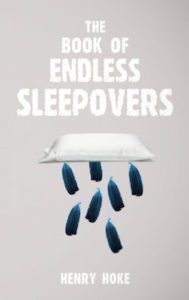
The ancient Greek word nostos pertains to the journey home a hero must make after a long war. It is a word rife with longing: for the familiar, the safe. It is a word that, in its current iteration, nostalgia, we hear a lot in reference to our particular cultural moment. Many Trump voters, for example, supposedly want to return to the 1950s, an era of American history they remember as simpler. Perhaps soon (or already) we’ll be yearning for the “idyllic” Obama years. Meanwhile, new shows like Netflix’s Stranger Things, and revivals of oldies like The X-Files, Gilmore Girls, Star Trek and Star Wars, tug at Millennials’ memories of 1980s childhood. Nostalgia is back in a big way, blanketing our culture in an ever-present hunger for the past.
This hunger is what Henry Hoke deftly examines in The Book of Endless Sleepovers. Dwelling in childhood and taking shape in short chapters of fragmented prose, Endless Sleepovers blurs the lines that divide poetry, lyric memoir, and fiction, speaking to another cultural moment: refusal of classification. But unlike work that seems hell-bent on experimentation, sometimes to the detriment of readability, in Endless Sleepovers Hoke builds his own genre, one that fits his own story and therefore his own talents, naturally. The result is a reading experience that is as quick and light as a freshly shaken Polaroid.
Hoke’s narration fluctuates from the first person I to a series of third person characterizations, seemingly of Hoke himself. Sometimes we follow “H,” sometimes “Mooney Sunshine.” Elsewhere in the book, Hoke inhabits the characters of “Huck” and “Tom,” whom he positions as players in a romantic boyhood game of friendship and desire. If this sounds confusing, it isn’t—a testament to the fluidity and command of Hoke’s voice, which is a silky Max Headroom with hints of melancholy, and to the organization of the text itself, each fragment titled and cordoned into its own thematic section.
And yet beneath the glossy coming-of-age tale Hoke weaves is always the hint of something warped. The child Hoke writes about rides bikes, builds forts, and forms crushes, but is also subject to sinister invasions, incursions from a dark, distinctly masculine, dimension. Divorce and bullying, confused sexuality, parental disability and a sense of patriarchal duty, all prod at the normality of childhood experience, functioning as a vortex of sorts, one in which “you have to be on the right side at the last second because everything on the wrong side will be decimated.” The urgency of being on the “right side,” functions as an undercurrent throughout the book. As in the “upside down place” of Stranger Things, or even the “mirror world” in Marvel’s recent blockbuster Dr. Strange, in Endless Sleepovers the parallel world is real and accessible. But often in Hoke’s world it seems the safe side is the upside down place. Hoke’s protagonist “is full of the desire to puncture that thin wall between [worlds] and cross over.”
In a short passage part-way through the opening section, “Bottomless Pit,” boyhood friends Tom and Huck enact the freedom and innocence they’ll someday miss:
The first time Tom and Huck are allowed to ride their bikes alone they stay out until sunset. They stop at the top of the biggest hill in their neighborhood. In the distance, they see two men crawl out of a storm drain and run away.
The scene ends there, leaving its meaning to the reader to decipher. Like many of Hoke’s fragments, this one seems vivid, but simple, cut-off too quickly, perhaps. But in this singular moment of enacted prose, the boys are privy not only to their first experience of autonomy, but to a vision of their own future as men, forever fleeing adulthood, its gendered weight and inevitable sadness. Here, we see a subtle hint of the book’s core preoccupation: the relationship between dangerous masculinity and idyllic childhood that each character must reckon with, even as they attempt avoidance and pray for endless sleepovers.
Later, as Endless Sleepovers draws to a close, Tom and Huck – along with the array of other characters Hoke follows – have left behind their hometown and boyhood friendship; yet Tom in particular longs to return to them both:
Huck is a constellation, Tom is all gazing up, can never know what Huck was ever thinking, if it ever meant as much, if he ever loved or felt the same way, if he even remembers.
Tom grounds himself in the groaning city.
Huck is a projection on the side of an express train flying by a hometown that Tom has long left behind.
Ultimately, and despite the nostos it constantly evokes, Hoke’s unique mixture of bittersweet remembrance and loss is pleasurable to read, made more so by the reader’s knowledge that once his characters cross over into the upside down world of permanent boyhood they dream of, they may find themselves frozen there, yearning for a past they can’t reclaim, trapped by their own nostalgia.
Hoke prods this yearning, circling it like a dangerous artifact known by many names. And dangerous it is, especially now, as Americans adjust to life in the upside down place that is Trump’s America. Even outside of our current cultural moment, Hoke’s book would feel important. But the unavoidable catastrophe of Trump’s presidency has launched The Book of Endless Sleepovers into the realm of mandatory reading. There are consequences to our fantasies, Hoke reminds us all, consequences to our unconscious lives. And it’s time to wake up.




